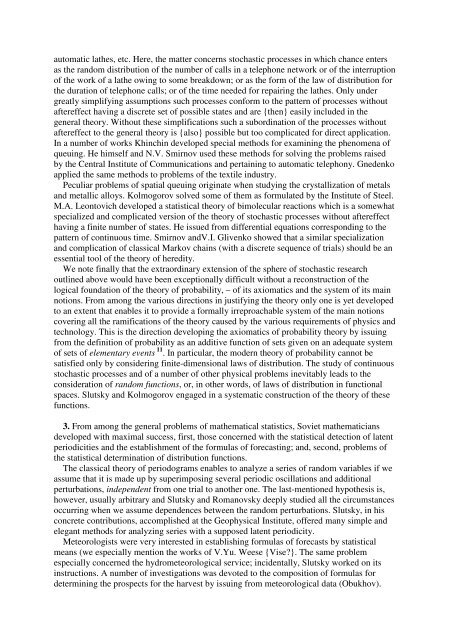7. Probability and Statistics Soviet Essays - Sheynin, Oscar
7. Probability and Statistics Soviet Essays - Sheynin, Oscar
7. Probability and Statistics Soviet Essays - Sheynin, Oscar
You also want an ePaper? Increase the reach of your titles
YUMPU automatically turns print PDFs into web optimized ePapers that Google loves.
automatic lathes, etc. Here, the matter concerns stochastic processes in which chance entersas the r<strong>and</strong>om distribution of the number of calls in a telephone network or of the interruptionof the work of a lathe owing to some breakdown; or as the form of the law of distribution forthe duration of telephone calls; or of the time needed for repairing the lathes. Only undergreatly simplifying assumptions such processes conform to the pattern of processes withoutaftereffect having a discrete set of possible states <strong>and</strong> are {then} easily included in thegeneral theory. Without these simplifications such a subordination of the processes withoutaftereffect to the general theory is {also} possible but too complicated for direct application.In a number of works Khinchin developed special methods for examining the phenomena ofqueuing. He himself <strong>and</strong> N.V. Smirnov used these methods for solving the problems raisedby the Central Institute of Communications <strong>and</strong> pertaining to automatic telephony. Gnedenkoapplied the same methods to problems of the textile industry.Peculiar problems of spatial queuing originate when studying the crystallization of metals<strong>and</strong> metallic alloys. Kolmogorov solved some of them as formulated by the Institute of Steel.M.A. Leontovich developed a statistical theory of bimolecular reactions which is a somewhatspecialized <strong>and</strong> complicated version of the theory of stochastic processes without aftereffecthaving a finite number of states. He issued from differential equations corresponding to thepattern of continuous time. Smirnov <strong>and</strong>V.I. Glivenko showed that a similar specialization<strong>and</strong> complication of classical Markov chains (with a discrete sequence of trials) should be anessential tool of the theory of heredity.We note finally that the extraordinary extension of the sphere of stochastic researchoutlined above would have been exceptionally difficult without a reconstruction of thelogical foundation of the theory of probability, – of its axiomatics <strong>and</strong> the system of its mainnotions. From among the various directions in justifying the theory only one is yet developedto an extent that enables it to provide a formally irreproachable system of the main notionscovering all the ramifications of the theory caused by the various requirements of physics <strong>and</strong>technology. This is the direction developing the axiomatics of probability theory by issuingfrom the definition of probability as an additive function of sets given on an adequate systemof sets of elementary events 11 . In particular, the modern theory of probability cannot besatisfied only by considering finite-dimensional laws of distribution. The study of continuousstochastic processes <strong>and</strong> of a number of other physical problems inevitably leads to theconsideration of r<strong>and</strong>om functions, or, in other words, of laws of distríbution in functionalspaces. Slutsky <strong>and</strong> Kolmogorov engaged in a systematic construction of the theory of thesefunctions.3. From among the general problems of mathematical statistics, <strong>Soviet</strong> mathematiciansdeveloped with maximal success, first, those concerned with the statistical detection of latentperiodicities <strong>and</strong> the establishment of the formulas of forecasting; <strong>and</strong>, second, problems ofthe statistical determination of distribution functions.The classical theory of periodograms enables to analyze a series of r<strong>and</strong>om variables if weassume that it is made up by superimposing several periodic oscillations <strong>and</strong> additionalperturbations, independent from one trial to another one. The last-mentioned hypothesis is,however, usually arbitrary <strong>and</strong> Slutsky <strong>and</strong> Romanovsky deeply studied all the circumstancesoccurring when we assume dependences between the r<strong>and</strong>om perturbations. Slutsky, in hisconcrete contributions, accomplished at the Geophysical Institute, offered many simple <strong>and</strong>elegant methods for analyzing series with a supposed latent periodicity.Meteorologists were very interested in establishing formulas of forecasts by statisticalmeans (we especially mention the works of V.Yu. Weese {Vise?}. The same problemespecially concerned the hydrometeorological service; incidentally, Slutsky worked on itsinstructions. A number of investigations was devoted to the composition of formulas fordetermining the prospects for the harvest by issuing from meteorological data (Obukhov).









